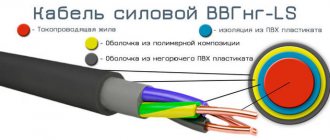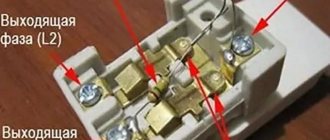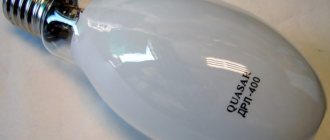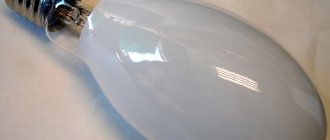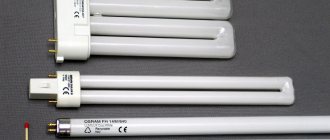The DRL lamp, which remains popular, is a representative of gas-discharge lighting devices, characterized by a rich luminous flux and durability. Products containing mercury have proven themselves in the installation of artificial lighting of streets and industrial facilities.
However, a number of technical and operational nuances prevent them from being used in everyday life and cast doubt on their appropriateness for use in other areas of life. You will learn everything about high-pressure gas-discharge lighting devices from our article. Our tips will help you choose the right devices.
Mercury lamp device
DRL lamps are classified as high-pressure gas-discharge devices. The priority area of use is lighting of streets, enterprises, garages and industrial workshops. DRLs are used where a powerful luminous flux is needed, and there are no special requirements for the quality of color reproduction.
Main functional parts:
- Flask. The outer shell of the device is made of heat-resistant glass. Inside there is a quartz burner to which conductors are connected. The electrodes are joined to the cathodes by connecting opposite polarities to a carbon resistor. Air has been pumped out of the flask, nitrogen has been pumped in, and the inner surface is coated with phosphor.
- Base. Responsible for receiving electricity from the network by connecting a point and threaded contact to a socket mounted in the lamp.
- Quartz burner. The main functional element of a mercury lamp. Structurally, it is a quartz flask in which electrodes are placed on both sides: two main ones and two additional igniting ones.
The space of the flask under pressure is filled with an inert gas, which ensures insulation of heat exchange between the internal environment and the burner. Additionally, literally a drop of mercury is added there. When cold, the mercury compound looks like a coating on the flask or has the shape of a ball.
To understand the principle of operation of a mercury-arc lamp, you should familiarize yourself with its structure and the role of its constituent elements
Design and principle of operation of a DRL type lamp
The design of the DRL lamp is quite primitive. The main structural elements of this light bulb are:
- glass container;
- threaded type base;
- mercury-quartz burner (tube);
- electrodes;
- carbon resistor.
The burner of a DRL light bulb has a tubular design and is filled with a strictly dosed amount of inert gases - argon and a little mercury. Electrodes facilitate the process of lighting the light bulb and make its glow more stable. The base, like any other light bulb, is designed to supply electrical energy to it, as well as to fix the lamp in the socket of the lighting fixture. The glass container, or bulb, is the outer shell of the light bulb.
During the manufacturing process of an arc phosphor lamp, air is pumped out of its bulb, and its internal space is filled with nitrogen. As the name of the light source in question suggests, the inner surface of the bulb is covered with a thin layer of phosphor.
The first sources of artificial lighting of a similar design included only a pair of electrodes and required an additional starting device. Due to this inconvenience, they were gradually discontinued in the 1970s. To ignite a modern four-electrode DRL lamp, only a choke device is required.
DRL lamp
The algorithm for this process is as follows:
- applying voltage to electrodes located close to each other;
- the occurrence of a glow discharge between the specified electrodes;
- this discharge covers the distance to the remaining electrodes, an arc discharge is formed between them;
- after some time (usually about 10-15 minutes), the light starts to light up normally.
Important! The period of time after which the light bulb reaches its normal combustion mode depends on the ambient temperature: at lower temperatures, its burning time increases. Mercury artificial lighting sources emit visible cool (blue) light, as well as powerful ultraviolet radiation, which provides the glow of the phosphor covering the inner walls of the lamp cylinder
As a result, we have a light bulb that produces bright white light. The color of the glow may change slightly if the voltage in the electrical network increases or decreases
Mercury artificial lighting sources emit visible cool (blue) light, as well as powerful ultraviolet radiation, which provides the glow of the phosphor covering the inner walls of the lamp cylinder. As a result, we have a light bulb that produces bright white light. The color of the glow may change slightly if the voltage in the electrical network increases or decreases.
During operation, such light bulbs heat up to a very high temperature. In this regard, they place increased demands on the quality of manufacture of the cartridge and base. In addition, the gas-discharge device of such an artificial lighting source must cool thoroughly before its subsequent use.
Operating principle: the essence of transient processes
The action of a mercury arc lamp is based on the processes of electrical discharge in a gaseous medium, occurring in a bulb under high pressure. This generates a glow source similar to the spiral in an incandescent light bulb. But it is not a hot tungsten filament, but a cord of glowing mercury vapor, “stretched” between the electrodes.
The persistent glow of the DRL lamp begins 8-10 minutes after energy is supplied. During this time, the current flowing in the lighting device is higher than the rated value, and is limited by the resistance of the ballasts.
The start-up duration depends on the ambient temperature - the colder it is, the longer it takes to “warm up” the lamp. After switching on, the mercury slowly evaporates when heated and gradually intensifies the discharge between the working electrodes.
When the mercury component completely transforms into gaseous form, and the pressure inside increases, the light bulb will reach maximum light output.
Electricity is supplied to the lamp, and a glow discharge is created between the main and ignition electrodes. As charge carriers accumulate, a breakdown occurs between two opposing main electrodes - arcing occurs
A voltaic arc in mercury vapor creates a glow of unacceptable color rendering, predominantly blue-green shades. The phosphor is responsible for converting UV radiation into red tones of light. Combining colors gives the white cool glow of a DRL light bulb.
Advantages and disadvantages
The main and undeniable advantages of using DRL lamps are their unchanging bright light, normal color rendition, reliability and long service life. Perhaps this is due to the application of a special phosphor composition to the inner surface of the flask.
They have wide power variations of 80, 125, 250, 400, 700 and 100 V. Other advantages include:
- color temperature 3800 °K;
- efficiency at 40 lm/V;
- long service life: from 10 to 15 thousand hours;
- low color rendering index (up to 45%).
Bulbs are sold in boxes
All this makes them quite popular and in demand on the market. For this, they are even forgiven for some shortcomings, which, by the way, are not so few:
- intensive formation of ozone during combustion, which is not very environmentally friendly;
- switching on can only be done using a special trigger control mechanism. Usually a choke is used for this, but at low temperatures of use it is necessary to connect an autotransformer;
- The process of switching on mercury arc lamps is always accompanied by a large inrush current. The startup itself may well take from 7 to 10 minutes. If you need to turn off the lamp and then turn it on again, you will have to wait about the same period of time. This is necessary for complete cooling of all structural elements.
You should not start lamps yourself without a choke.
Some pros can be turned into cons. Color rendering is quite low, although it is quite sufficient for production and warehouse premises. The color temperature is also not the highest. However, if the voltage in the power supply network drops by more than 10%, then the light bulb will not be able to go out, and the light bulb will not be able to light up.
Connecting DRL via choke
Important! It is also worth paying attention to the fact that the DRL has an impressive pulsation coefficient and a blue-green spectrum, and its luminous efficiency is halved after 2000 hours of operation
Application specifics: pros and cons of lamps
DRL type illuminators are mainly installed on poles to illuminate streets, roadways, park areas, adjacent areas and non-residential buildings. This is due to the technical and operational characteristics of the lamps.
The main advantage of mercury-arc devices is their high power, which provides high-quality lighting of spacious areas and large objects.
It is worth noting that the DRL passport data on luminous flux is relevant for new lamps. After a quarter, brightness deteriorates by 15%, after a year - by 30%
Additional benefits include:
- Durability. The average operating life declared by manufacturers is 12 thousand hours. Moreover, the more powerful the lamp, the longer it will last.
- Work at low temperatures. This is a decisive parameter when choosing a lighting fixture for the street. Gas-discharge lamps are frost-resistant and retain their performance characteristics at sub-zero temperatures.
- Good brightness and lighting angle. The light output of DRL devices, depending on their power, ranges from 45-60 Lm/V. Thanks to the operation of the quartz burner and the phosphor coating of the bulb, a uniform distribution of light with a wide scattering angle is achieved.
- Compactness. The lamps are relatively small, the length of a 125 W product is about 18 cm, a 145 W device is 41 cm. Diameter is 76 and 167 mm, respectively.
One of the features of using DRL illuminators is the need to connect to the network via a choke. The role of the intermediary is to limit the current feeding the light bulb. If you connect a lighting device bypassing the choke, it will burn out due to the large electric current.
The connection is schematically represented by a series connection of a mercury phosphor lamp through a choke to the power supply. Many modern DRL illuminators already have a ballast mechanism built into them - such models are more expensive than conventional lamps
A number of disadvantages limit the use of DRL lamps in everyday life.
Significant disadvantages:
- Duration of ignition. Reaching full illumination – up to 15 minutes. It takes time to heat up the mercury, which is very inconvenient at home.
- Sensitivity to the quality of power supply. If the voltage drops by 20% or more from the nominal value, it will not be possible to turn on the mercury lamp, and the glowing device will go out. When the indicator decreases by 10-15%, the brightness of the light deteriorates by 25-30%.
- Noise during operation. The DRL lamp makes a buzzing sound, not noticeable on the street, but noticeable indoors.
- Ripple. Despite the use of a stabilizer, the light bulbs flicker - it is undesirable to work for a long time in such lighting.
- Low color rendering. The parameter characterizes the reality of perception of surrounding colors. The recommended color rendering index for residential premises is at least 80, optimally 90-97. For DRL lamps, the indicator value does not reach 50. With such lighting it is impossible to clearly distinguish shades and colors.
- Unsafe use. During operation, ozone is released, so when using the lamp indoors, a high-quality ventilation system is required.
In addition, the presence of mercury in the flask itself poses a potential hazard. These bulbs cannot simply be thrown away after use. To avoid polluting the environment, they are disposed of appropriately.
Another limitation of the use of gas-discharge lamps in everyday life is the need to install them at a considerable height. Models with a power of 125 W – 4 m suspension, 250 W – 6 m, 400 W and more powerful – 8 m
A significant disadvantage of DRL illuminators is the impossibility of turning them on again until the lamp has completely cooled. When the device is operating, the gas pressure inside the glass flask increases greatly (up to 100 kPa). Until the lamp cools down, it is impossible to break through the spark gap with the starting voltage. Restart occurs after about a quarter of an hour.
Technical and operational characteristics
As the glass flask is heated, the mercury scattered on its surface (in the form of drops) begins to evaporate. The stronger the evaporation process, the stronger the discharge between the electrodes and cathodes. The nominal mode of the DRL lamp is the moment when all drops of mercury are converted into steam.
The product is characterized by increased sensitivity to temperature changes, so its functionality without a flask is impossible (based on physical laws).
The flask is responsible for two important functions:
- Barrier between the gas-discharge chamber with mercury vapor and the environment.
- Acceleration of the process of converting ultraviolet rays into a red light spectrum, which is possible due to the presence of phosphor on the walls. To the red glow is added green, generated by an internal discharge, which leads to the appearance of white light.
Voltage surges greatly affect the operation of the DRL lamp. A deviation from the nominal value of 10–15% is considered acceptable, but if this value is equal to 25–30%, the glow will become uneven. With an even greater reduction, the lamp will either not light up or go out (if it was in operation before).
Decoding product markings is very simple - the number indicates the lamp model, which coincides with the rated power.
The table below shows the parameters of specific DRL models:
| Model | Rated voltage, V | Power, W | Length, mm | Diameter, mm | Base | Luminous flux, lm | Durability, h |
| DRL-125 | 125 | 125 | 177 | 77 | E27 | 6000 | 12 000 |
| DRL-250 | 130 | 250 | 227 | 90 | E40 | 13 500 | 15 000 |
| DRL-400 | 135 | 400 | 290 | 121 | E40 | 25 000 | 18 000 |
| DRL-700 | 140 | 700 | 356 | 151 | E40 | 40 000 | 20 000 |
| DRL-1000 | 145 | 1000 | 412 | 168 | E40 | 60 000 | 18 000 |
Selection criteria: assessment of technical indicators
When determining the optimal lighting fixture, you should take into account the following characteristics:
- power;
- shape/size of the base;
- luminous flux brightness;
- duration of work.
Power. When choosing this option, you should focus on the purpose and location of the lamp. If a device is purchased to illuminate the road, then you need to take into account the distance between the lamps - the greater it is, the more efficient the lamps should be.
The range of power characteristics of DRL illuminators is in the range of 80-1000 W. This value is displayed in the lamp markings, for example, DRL 250, DRL 400, etc.
Light flow. The main indicator of light radiation directed in different directions. The parameter is measured in lumens (Lm). It is by this criterion, and not by power, that it is necessary to compare the performance of different types of lamps.
Lamps with a DRL lamp consume more electricity to produce the required luminous flux than their LED counterparts and DNAT illuminators. The brightness of an LED device of 100 W corresponds to the illumination indicator of its mercury-arc counterpart of 400 W
Significant savings on energy resources are a strong argument in favor of LEDs. The high cost of LED lamps pays off in the first year of operation.
Base. DRL illuminators are available with the two most popular types of bases:
- E27 – screw shape, diameter – 27 mm. Mercury-arc devices of 80 W and 125 W are equipped with this base.
- E40 is the largest size in the “E” category. The 40 mm base is used in lamps rated at 250 W and above, intended for lighting large areas.
In addition to the type of screwing into the socket, you should also take into account the dimensions of the lamp shade.
The width and length of the gas discharge lamp depends on the power of the device. The higher the performance of the DRL illuminator, the larger and heavier it is
Duration of service. This parameter is largely determined by the quality of workmanship, namely the responsibility of the manufacturer. It is better to choose lamps with a maximum service life. As a rule, high-power devices have a longer service life.
For clarity, the general characteristics of lamps of different powers are shown in the summary table. All electrical appliances operate on alternating current, the standard frequency is 50 Hz
Some information about the characteristics of lamps is included in the labeling. In domestic practice, the letter abbreviation denotes the name of the illuminator, and the digital abbreviation denotes power. The production of mercury lamps is regulated by GOST 27682-88 and GOST 53074-2008.
Foreign products of the DRL type are marked QE according to the international ILCOS system. Some manufacturers adhere to the pan-European ZVEI and German LBS designation order.
Markers for mercury lamps from popular companies:
- HPL – Philips;
- HRL – Radium;
- MBF – General Electric;
- HQL - Osram;
- HSL and HSB – Sylvania.
Additional designations according to ILCOS: QB – models with built-in ballast, QG – spherical bulb, QR – lamps with a reflective inner layer.
Connection diagram for DRL lamp via inductor
There are many objects where lighting devices with high luminous power are required. At the same time, they must be economical and have a long service life. DRL lamps fully comply with these requirements. The power of DRL lamps is in the range of 50-2000 W; their operation requires a single-phase network of 220 V and a frequency of 50 Hz.
The most important part of the DRL is the throttle, without which they simply cannot work. The fact is that during the startup process and subsequent operation, these lighting devices come under the influence of variable starting currents and resistances. Therefore, to limit the operating current, the DRL is connected through a choke, which is a heterogeneous ballast in the form of inductors. At the moment of startup they have high resistance. When the lamp is ignited in a gas environment, an electrical breakdown occurs, leading to the occurrence of an arc discharge.
In the process of igniting the lamp, the ionized gas under the action of an arc discharge loses its resistance many times. For this reason, the current increases with the simultaneous release of heat. If the magnitude of the current is not limited, a superheated gaseous environment will instantly arise under its action. Internal parts will be damaged and the lighting fixture will fail completely. To prevent negative consequences, a DRL lamp connection circuit is used together with a choke, which creates the necessary resistance.
Connecting the DRL lamp through a choke, connected in series with the lamp. Its reactance is closely related to the parameters of the inductor. That is, 1 henry of inductance is capable of passing 1 A of current at a voltage of 1 V. The main characteristics of the coil are the cross-sectional area of the copper conductor and the number of its turns, as well as the core material and the cross-section of the magnetic circuit. The magnitude of electromagnetic saturation is of great importance.
It should be taken into account that the inductor also has active resistance. This must be taken into account when calculating the ballast for each type of DRL light bulb, since the size of the inductor itself will depend on the power of the lamp. To more correctly connect the inductor to the DRL, you should consider the simplest circuit that ensures the appearance of a glow discharge and its further transition into an electric arc. This connection makes it possible, using the inductance of the choke, to limit the operating current in the lamp to the desired value. In this case, long-term stable operation of the lamp is guaranteed, without any failures.
This scheme for switching on a DRL lamp is considered the simplest. It consists of the lamp itself and the choke, connected in series to each other. The resulting circuit is connected to a 220 V electrical network with a standard frequency of 50 Hz. Thus, DRL lamps can be used at home without any problems. The choke for DRL lamps in this circuit performs the functions of a stabilizer and work corrector. Its use makes it possible to accurately answer the question of why DRL lamps blink without a choke, since it is this device that provides even and stable light. Without it, it is impossible to connect normally and start the workflow.
Which manufacturer should you prefer?
It is recommended to choose products from well-known brands; it is better to refrain from buying cheap “nameless” Chinese light bulbs.
The following ]mercury devices[/anchor] have won trust among buyers:
- Osram (Germany);
- Philips (Netherlands);
- General Electric (USA/Hungary);
- Next (Poland);
- Eurosvet (Ukraine);
- Lisma (Russia);
- DeLux (China).
In the European market, two brands are considered leaders in the production and sale of lighting products: Osram and Philips. Both companies have many years of experience - more than a century, a wide range and a developed sales network.
The operating parameters of DRL lamps from leading manufacturers correspond to the declared characteristics, the devices have high efficiency - at a power of 250 W, the light flux reaches 12,500 lm. Estimated cost – 8-10 USD.
The American company General Electric has factories in Europe. The quality of the goods and service life are not inferior to previous brands, and the price is slightly lower. For a DRL illuminator with a power of 250 W you need to pay about 7 USD.
E.Next is an electrical engineering holding, where the main manufacturer of devices is the Tarel group of Polish companies. The product line includes numerous series of different lamps for home, street and industrial lighting.
E.Next 250 W illuminators, compared to German and Dutch-made lamps of similar power, are inferior to competitors in color rendering (Ra=40) and service life (12,000 hours). Approximate price – 5 USD
Mercury-arc lamps of Russian, Ukrainian and Chinese brand production are in the same price category, the average cost of products for 250 W is 3 USD. The disadvantage of lighting devices is their limited operation - according to the passport data, the light bulbs will last 5000 hours.
Before purchasing, you need to check the base for the quality and “accuracy” of the thread - some users note the difficulty of screwing Lisma lamps into the socket
Advantages and negative qualities
What is good and what is bad about DRL 250 lamps? The characteristics of their development provide them with the following positive indicators:
- Very high light output compared to other lighting devices.
- No dependence on precipitation.
- An impressive service life, which can easily reach 20 thousand hours.
- The emission spectrum is very close to natural light.
- Small own dimensions.
The disadvantages of lamps are:
- Formation of ozone during operation.
- Quite a high price (such lamps are 5–7 times more expensive than a regular incandescent lamp).
- In some cases, tungsten analogues will have smaller dimensions than DRL.
- After several months of operation, the emitted light spectrum changes as the technical characteristics of the phosphor layer change.
- The presence of mercury forces users to dispose of lamps according to a special scheme, separately from other goods, things, and products.
- Switching on occurs with some delay, and it takes several minutes to achieve combustion at full power.
- The light from such lamps is of rather low quality.
- Very high flicker factor during operation.
- It is best to hang lamps at a height of at least four meters.
- Towards the end of its service life, the luminous flux of the device decreases significantly.
- The lamp can only operate on alternating current.
Comparison of DRL light bulbs with analogues
Discharge lamps are often compared with each other and with more profitable LEDs. The closest analogues of DRL are three types of illuminators: DRI, DRI and DNAT. Let's try to identify the features and competitive advantages of different light bulbs.
DRV. A mercury-tungsten arc lamp is very similar in design and operating principle to a DRL. Structurally, inside the flask there is a mercury discharge torch and a tungsten spiral. The last element limits the current for the burner, which means that additional ballasts are not needed.
The main differences between mercury-tungsten lamps and DRLs:
- They consume more electricity - the luminous flux of DRV 250 is no more than 5500 Lm;
- estimated operating time – 3000 hours;
- lights up within 1 minute.
DRI. Mercury arc lamps with emitting additives: indium, sodium, thalium halide, etc. Metal components increase the light output of devices to 75-90 Lm/W.
An additional advantage of metal halide mercury lamps is improved color rendering. To operate DRI, like DRL, they require connection via a choke
DNAT. Sodium arc lamps boast the highest light output and longest operating life among discharge illuminators. The performance of sodium light bulbs does not decrease as noticeably over time as DRL lamps.
Characteristics of DNAT:
- maximum light output – 125 Lm/W;
- operability – within 20 thousand hours;
- relative stability of parameters;
- wide range of operating temperatures;
- reaching maximum illumination in 5-7 minutes.
Disadvantages of sodium light sources: significant pulsation and low color rendering coefficient, Ra=25. The emission spectrum is dominated by red and yellow colors.
Discharge lamps are confidently giving way to LED options. LED devices are superior to their predecessors in all technical and operational parameters.
The undeniable advantages of LEDs: environmental friendliness, minimal pulsation, service life, instant switching, excellent color reproduction and contrast. In addition to excellent performance characteristics, diode devices have temperature and mechanical resistance.
The efficiency of LED lamps is unrivaled, operating efficiency reaches 95-98%. The main factor somewhat constraining the re-equipment of lamps is the high price of LED lamps
Economic justification for replacing the lamp
Let's calculate the operating costs:
Let's compare DRL 400 and a 100W E40 LED lamp. With daily use for 12 hours, the LED will last about eleven years. For 50,000 hours of operation, energy consumption will be 5000 kW/h.
Electricity costs – 5000 kW/h x 0.3 c.u. = 1500 c.u.
For a similar period of operation of a mercury source, 5-6 light bulb replacements will be required. Energy consumption will accordingly be 20,000 kW.
Electricity costs – 20,000 kW/h x 0.3 c.u. = 6,000 c.u.
The real numbers will be even higher, since the mercury light source is launched through a ballast, which itself is an energy consumer, electricity costs will be 10-15% higher.
Just replacing one mercury bulb with an LED bulb before the end of its life will save more than four thousand dollars.
At industrial facilities there can be dozens, and sometimes hundreds, of such lamps.
Despite the significantly higher cost of LED sources, they have extremely low energy consumption, which pays off the initial costs literally within the first half of the year of operation.
Finally, check out this monster of a light that consumes just over 0.5 kW. https://www.youtube.com/embed/91QP9JBDx8s
Requirements for disposal of mercury devices
You cannot thoughtlessly throw away used or defective mercury-containing light bulbs. Devices with a damaged bulb are a serious threat to human health and the environment as a whole, and therefore require specific disposal.
The question of the procedure for disposing of unsafe waste is relevant both for business owners and for ordinary residents. The processing of mercury lamps is carried out by organizations that have received the appropriate license.
The company enters into a service agreement with such a company. Upon request, a representative of the recycling company goes to the site, collects and removes the lamps for subsequent disinfection and recycling. The estimated cost of the service is 0.5 USD per lighting fixture.
Collection points have been set up to collect mercury-containing light bulbs from the population. People living in small towns can recycle hazardous waste through an “eco-mobile”
If the emission of mercury-containing lamps by enterprises is somehow controlled by regulatory authorities, then compliance with the rules of disposal by the population is the personal responsibility of citizens.
Unfortunately, due to low awareness, not every user of mercury lamps is aware of the possible consequences of mercury vapor entering the surrounding atmosphere.
All types of energy-saving lamps are described in detail in the following article, which discusses the principles of operation, compares the devices, and provides a simplified economic assessment.
How to properly connect a DLR 125 lamp
There are two methods for connecting the DRL 125. This can be done with or without a choke. These two methods are described in detail below.
Throttle
This connection diagram is quite easy and involves a serial connection of the inductor circuit and the DRL 250 light bulb itself. The connection is made to a 220 volt network and operates at a classic frequency. Therefore, it is very easy to connect such light bulbs to your home network.
The throttle will act as a stabilizer and corrector of the work process. Thanks to it, the light bulb will not flicker, it works constantly, and the light beam does not change when the incoming voltage fluctuates.
Connection diagram via inductor
Attention! Connection without a choke is impossible, because the product will burn out instantly. To operate, the circuit must be powered by a sufficiently high voltage, which from time to time reaches a level equal to three or four incoming voltages
To operate, the circuit must be powered by a sufficiently high voltage, which from time to time reaches a level equal to three or four incoming voltages.
No throttle
If you need to use the DRL 125 light bulb model as a regular device without using a classic choke, then it can be connected using professional technology.
The easiest connection method would be to purchase a special light bulb that can function without a choke. It is equipped with a special burner that acts as a stabilizer and can dilute the light beam. But this connection method is not recommended for a person without electrical skills. It is very complicated, so it is better to seek help from a professional.
Connection process
You must also remember to properly store and dispose of these lamps. Since they contain a small percentage of mercury, such lamps should not be thrown into the trash or kept in a bag. Used devices must be taken to a recycling facility (they can be found at hardware stores). Unused lamps should only be stored in cardboard boxes, away from children and animals. If the DRL 125 is broken, then the first thing you need to do is ventilate the room, and then do a wet cleaning.
Many electricians do not recommend installing such light bulbs in houses or apartments. They do not illuminate the room sufficiently and are also hazardous to health. Such devices are only suitable for street use or in warehouses.
Proper storage
DRL 125 light bulbs are perfect for lighting courtyards, streets, verandas or parking lots. You can simply connect them yourself using a choke
But, of course, it is important to follow all safety rules when working.
Conclusions and useful video on the topic
The proposed video review describes the design of the DRL illuminator, describes in detail the principle of operation and notes the main nuances of operation:
DRL type gas discharge lamps are still used in street lighting. The main argument in favor of mercury devices is the powerful luminous flux and affordable cost. However, they are gradually being replaced by more advanced lamps, which, along with high efficiency, boast good glow quality and safety of use.
Please write comments in the block below, ask questions and post photos on the topic of the article. Share useful information that will be interesting and useful to site visitors. Tell us about your own experience in choosing and installing a high-pressure discharge light bulb.
How to properly connect a DRL 400 lamp
If you want to connect the DRL as a lamp without using a special choke, you will have to resort to other methods. The easiest way is to purchase a special DRL foot, which will work normally without a throttle. Such samples use a special spiral that works as a stabilizer.
Important! If you use a regular DRL lamp without a choke, it will burn out instantly, since the voltage to start it can be very high. You can remove the inductor by adding several capacitors to the overall design
It is important to correctly calculate the current they produce.
For all its shortcomings, DRL is a good lamp for certain tasks
Thus, the DRL 400 light bulb was considered, which has found its wide use in industrial premises, on the streets and in uncrowded places. Using it precisely in these conditions, you can win significantly.
